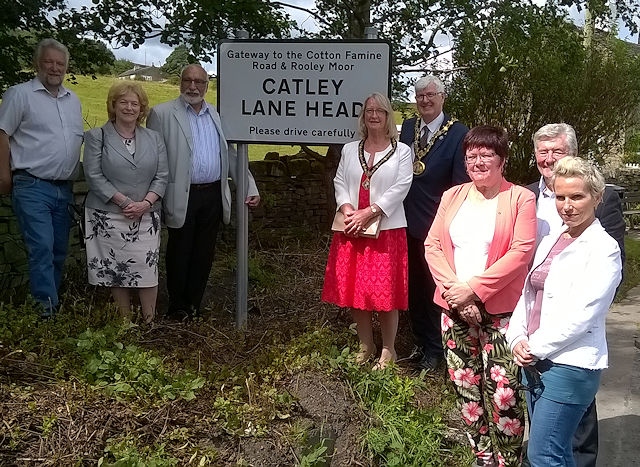Community event celebrates the history of Catley Lane Head and Cotton Famine Road
Date published: 14 August 2017
The second neighbourhood event in Lanehead Village, near the top of Rooley Moor Road, took place on Sunday 13 August to celebrate 12 months since the launch of the Rooley Moor Neighbourhood Forum and the new signage for the village taking in the original name of the village, Catley Lane Head.
Sue Devaney explained the history of the village and the relevance of the Cotton Famine Road, the old Rooley Moor Road which goes over the moors to Bacup.
The Mayor and Mayoress, Ian and Christine Duckworth, Rochdale MP Tony Lloyd, and councillors Cecile and Surinder Biant attended.
There was live music from the Cotton Famine Road Band, clog dancing and music from Oakenhoof, exhibitions about the neighbourhood plan and consultation, food and drink.
Alan Rawsterne, Secretary, Rooley Moor Neighbourhood Forum said: “As part of the event this year the new road sign in Catley Lane Head (identifying the area as the gateway to Rooley Moor) was officially unveiled by the Mayor and Mayoress of Rochdale and Rochdale’s new Member of Parliament, Tony Lloyd.
“The Forum is extremely grateful to the Greater Manchester Police for funding the road sign to promote careful driving, and to Rochdale Council for their support in delivery of the sign, as well as their support of this year’s event.”
Tony Lloyd MP said: “It’s a genuine privilege to be here today.
“It’s important to recognise the story of the Cotton Famine, I’m a Northerner and grew up with the norther traditions, what really annoys me is that no one told me of these stories as a child, I had to wait until I was an adult to find out about the Cotton Famine.
“That local people suffered for a phenomenally human cause, that people would refuse to deal with slave cotton, such a magnificent gesture, and people who saw their families suffer, because they were not prepared to accept slavery in any form, and human solidarity is something we can learn a lot from in every generation.”
Mayor Ian Duckworth said: “Its great to be here today, my grandmother worked in a mill and when my mother was 12 her name was put down to work there as well, and all her sister’s in there turn as well.
“I am proud to be a descendant of them and proud to be your Mayor her today.
Talking about the Cotton Famine Road and how the mill workers supported the slave workers in America he said: “I have no doubt that Rochdaledalians would do exactly the same today.”
Sue Devaney said: “Climbing over Rooley Moor, past Catley Lane Head and on to Whitworth, the scar of Rochdale’s “Cotton Famine Road” is a landmark that has been clearly visible from most parts of Rochdale and beyond for centuries.
“By the middle of Queen Victoria’s reign Lancashire had 4,500 mills and some of the men and women who were impoverished by the cotton famine understood that the last hands to have touched the bales of cotton that arrived in the mills were those of the black slaves who had loaded them onto ships.
“The Lancashire towns from which unions and cooperative societies emerged were those that most firmly supported the North and its advocacy of free labour. The town most strongly pro-North and most passionately anti-slavery was Rochdale, where abolitionist and anti-slavery societies had been vocally active long before the outbreak of the American Civil War”.
“This road, this village, this area and Rochdale has a very proud association with the abolition of slavery and there are many significant names, such as then local MP John Bright, who supported the Northern American states in their fight against slavery in the cotton fields of America’s Southern states.
“Many of Lancashire’s cotton workers followed the lead of Bright and this stance led to widespread poverty and starvation in the County, including Rochdale, Bright’s hometown.
“Thousands of workers were unemployed, relying on a combination of charity, and Poor Relief from the Board of Guardians. This relief came in the form of payments for work carried out under the Public Works Act of 1863. This Act was made specifically to enable the Poor Law Guardians to borrow money at a low rate of interest, which they could then use to finance work-creating projects.
“By March 1863, the distress caused by the cotton famine in Rochdale was widespread, with mass unemployment resulting in “Outdoor Relief” being paid to 19,374 people.
“One of the Rochdale Union’s projects was for improvements in Catley Lane.
“And the resulting repair work with lengths of the road being paved with up to one third of a million stone setts that are still in existence today.
“This road is undoubtedly a monument to the courage and suffering of the cotton workers of Rochdale in those dark years, and you, the residents of Catley Lane Head, are the guardians of this precious gem! And perhaps like the previous residents of Catley Lane you have a responsibility to make sure the story is never forgotten and that the road remains for future generations to enjoy.”
Do you have a story for us?
Let us know by emailing news@rochdaleonline.co.uk
All contact will be treated in confidence.
Most Viewed News Stories
- 1Middleton school hails another outstanding inspection result
- 2Drugs and cash seized during morning raids at suspected stash houses
- 3Former councillor and hospital campaigner Jean Ashworth has died
- 4No trams between Oldham and Rochdale this Sunday
- 5Northern Healthcare opens supported living service in former Rochdale hotel
To contact the Rochdale Online news desk, email news@rochdaleonline.co.uk or visit our news submission page.
To get the latest news on your desktop or mobile, follow Rochdale Online on Twitter and Facebook.



